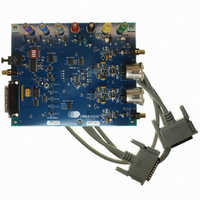CDB4398 Cirrus Logic Inc, CDB4398 Datasheet - Page 24

CDB4398
Manufacturer Part Number
CDB4398
Description
BOARD EVAL FOR CS4398 DAC
Manufacturer
Cirrus Logic Inc
Specifications of CDB4398
Number Of Dac's
2
Number Of Bits
24
Outputs And Type
2, Differential
Sampling Rate (per Second)
192k
Data Interface
I²C, SPI™
Dac Type
Voltage
Voltage Supply Source
Analog and Digital
Operating Temperature
-10°C ~ 70°C
Utilized Ic / Part
CS4398
Description/function
Audio D/A
Operating Supply Voltage
5 V
Product
Audio Modules
For Use With/related Products
CS4398
Lead Free Status / RoHS Status
Contains lead / RoHS non-compliant
Lead Free Status / RoHS Status
Lead free / RoHS Compliant, Contains lead / RoHS non-compliant
Other names
598-1155
24
4.7.6
D S D _S C LK
D S D N orm al M ode
Direct Stream Digital (DSD) Mode (Control Port Mode)
In Control Port mode, the FM bits (Reg. 02h) are used to configure the device for DSD mode. The DIF
bits (Reg 02h) then control the expected DSD rate and MCLK ratio.
The DSD_SRC bit (Reg. 02h) selects the input pins for DSD clocks and data. During DSD operation, the
PCM-related pins should either be tied low or remain active with clocks. When the DSD related pins are
not being used, they should either be tied low or remain active with clocks.
The DIR_DSD bit (Reg 07h) selects between two proprietary methods for DSD-to-analog conversion. The
first method uses a decimation-free DSD processing technique that allows for features such as matched
PCM level output, DSD volume control, and 50 kHz on-chip filter. The second method sends the DSD data
directly to the on-chip switched-capacitor filter for conversion (without the above mentioned features).
The DSD_PM_EN bit (Reg. 09h) selects Phase Modulation (data plus data inverted) as the style of data
input. In this mode, the DSD_PM_mode bit selects whether a 128Fs or 64x clock is used for phase mod-
ulated 64x data (see Figure 13). Use of phase modulation mode may not directly effect the performance
of the CS4398, but may lower the sensitivity to board-level routing of the DSD data signals.
The CS4398 can detect errors in the DSD data that do not comply to the SACD specification. The
STATIC_DSD and INVALID_DSD bits (Reg. 09h) allow the CS4398 to alter the incoming invalid DSD da-
ta. Depending on the error, the data may either be attenuated or replaced with a muted DSD signal (the
MUTEC pins would set according to the DAMUTE bit (Reg. 04h)).
More information for any of these register bits can be found in the Register Description section.
The DSD input structure and analog outputs are designed to handle a nominal 0 dB-SACD (50% modu-
lation index) at full rated performance. Signals of +3 dB-SACD may be applied for brief periods of time;
however, performance at these levels is not guaranteed. If sustained +3 dB-SACD levels are required,
the digital volume control should be set to -3.0 dB. This same volume control register affects PCM output
levels. There is no need to change the volume control setting between PCM and DSD in order to have the
0 dB output levels match (both 0 dBFS and 0 dB-SACD will output at -3 dB in this case).
D S D _A ,
D S D _B
(64Fs)
BCKA
D 0
D 0
Figure 13. DSD Phase Modulation Mode Diagram
D 1
D 1
D 1
D 2
D 2
D S D _A ,
D S D _B
(128Fs)
BC KA
(64Fs)
BCKD
M odulation M ode
D S D P hase
D S D _S C LK
D S D _S C LK
CS4398
DS568F1



















